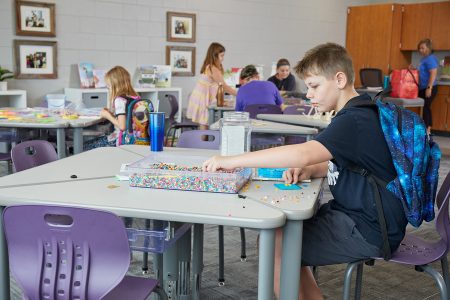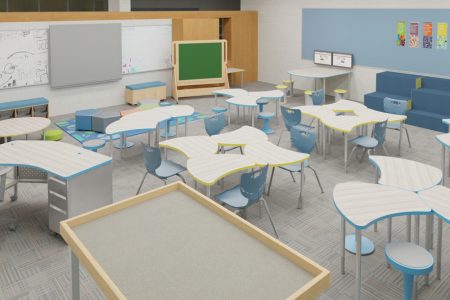 One area of school redesign and referendum projects that often gets overlooked is the importance of having a communication strategy to discuss and describe the scope and vision of the work. Without this strategy, it can be difficult to get both your internal and external stakeholders invested in your project and the future of learning at your school.
One area of school redesign and referendum projects that often gets overlooked is the importance of having a communication strategy to discuss and describe the scope and vision of the work. Without this strategy, it can be difficult to get both your internal and external stakeholders invested in your project and the future of learning at your school.
Changing your learning spaces without explaining the “why” behind the redesign can leave audiences — both your community members and your staff — guessing. By creating a communication strategy, you can begin to sculpt a new narrative and mental model around how learning spaces support modern teaching and learning.
Follow the steps below to craft a compelling message to your staff and your community members to garner their support for your redesign project.
Tie Your Goals to Your District’s Current Initiatives
From the beginning, your communication strategy must showcase that the shifts in the design of your learning spaces are in line with your district’s current strategic initiatives. When you ask your community to contribute financially through their tax dollars, you should be able to provide a clear crosswalk to the vision and mission of your school system.
Without this clear alignment to your mission, school staff, who probably already feel overwhelmed and pressed for space and time, can begin to suffer from initiative fatigue. This same fatigue can affect your taxpaying community members, who may feel that the schools are adding more and more unnecessary extras and wasting limited taxpayer dollars. To avoid this perception and garner support for your project, keep the focus of your message on how the proposed design changes line up with the core learning elements of the district. Then provide evidence and research to back up your proposal. This will help you avoid the perception that the shifts are just an interior decorating exercise.
Identify Your Audience
Too often, districts fail to identify in detail the audiences, both internal and external, that need targeted messaging about the learning space project. Missing an audience creates an opening for a skewed narrative to emerge.
Start by first brainstorming the different audiences that have a stake in the outcome of your project and then detail the current perceptions for each audience. You’ll use these notes to craft your unique messages to them. Your audiences could include the following:
- Internal: Teachers, secretaries, counselors, custodians, maintenance staff, students, leadership
- External: Parents, taxpayers, business owners, civic leaders, partner organizations
You’ll then want to create a detailed analysis of your audience types, including the messages you want to deliver to them and the types of media you’ll use to promote your message.
Focus Your Message
The messages that you craft for your audiences should be simple, clear, and consistent. Keep the following in mind when crafting them:
- Internal: Make sure that your staff and other internal stakeholders know that the design work is a student-focused initiative. It will support students both academically and in their social and emotional growth. Provide research that details the benefits of redesigning your learning spaces:
- External: Audiences beyond the walls, including community members, business owners, and other stakeholders, will want to understand the impact that investing their tax dollars in redesigning your learning spaces will have on learning outcomes. They need to know that where kids learn matters and that when students learn in modern spaces, it prepares them for future careers, work styles, and interactions with others.
Objections that come from community members can center around not wanting to invest in something because “that’s not how they did it in my day and we turned out just fine.” It can help to counter this message with some statistics about the changing landscape of careers and the rapidly evolving demands of modern society.
Just as with your internal audiences, you should craft a compelling message that includes the research behind your new spaces and how modern classroom design can help develop the skills students need to succeed in college and in their future careers.
Match Your Message to Your Medium
In an era when focus and attention are at a premium, schools and districts need to be laser-focused on making sure that their message doesn’t get lost in the noise. In order to be successful, think about spreading your message like a strategic marketer would: identify your audiences and figure out the concise message that you want to bring to them. Then, use the right medium to convey your message to make it truly effective.
To figure out the right media outlets for each audience, first consider all of the options that are available. Many audiences receive their communication from one or two channels and fully mute others. If you are speaking into the wrong channels, it is like you are yelling into the forest.
Consider where your audience is most likely to hear your message: social media channels; local TV, radio, and newspapers; local businesses; public gathering spaces such as community centers or public libraries; public forums; or school websites, written communication, or email. You’ll want to use one or all of these that fit each audience.
In addition to selecting the right mix of media outlets, it is important for schools and districts to continue to reinforce their message. Schools and districts often promote their initiatives in a singular moment. Good marketers know that it takes up to 20 impressions for audiences to hear, digest, and connect with messaging. Look for ways to continually reiterate your message, and make these concepts a part of your overall strategy for success.
Leverage Your Biggest Supporters
As you build a compelling narrative to amplify the need to revamp your learning spaces and modernize your classroom design, don’t forget that three voices rise above the rest: teachers, students, and your design team.
The community wants to hear that teachers see these changes as positive for their work and for the children they serve. Bring teachers into your communications strategy. Let them be lead voices internally and externally to build energy around this work. When their opinions are taken into consideration and they feel like they are an important part of the decision-making process, they will be your biggest advocates, along with your design team.
Most importantly, let student voices ring out. Our students know the power of well-designed learning spaces. They bring them joy and raise their interest in school, and this story is essential to the overall success of your project. If you can, make some changes to at least one learning area and solicit feedback from students; you can then use that feedback to support your argument for new spaces.
Conclusion
Schools and districts leaning into the work of redesigning spaces into modern places for learning need to communicate with internal and external audiences to ensure that the power and impact are felt beyond the walls of the school. Developing a comprehensive communication strategy that drives the shift in thinking will help fund your modern spaces and will provide the best chances for student growth and success.
Dr. Robert Dillon
Latest posts by Dr. Robert Dillon (see all)
- How to Manage Your Active Classroom - April 22, 2020
- Answers to Your Questions About Effective Library and Classroom Design - April 2, 2020
- How to Measure the Success of Your New Learning Space Design - March 3, 2020
- How to Get Your Community and Staff Invested in Redesigning Your Learning Spaces - January 13, 2020
- 3 Ingredients of Active Learning Spaces - October 16, 2019



